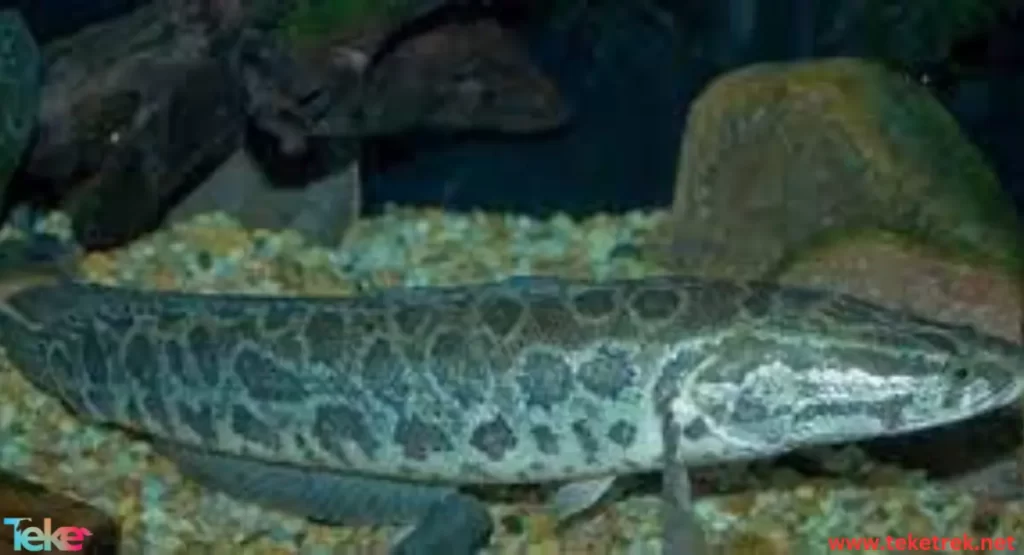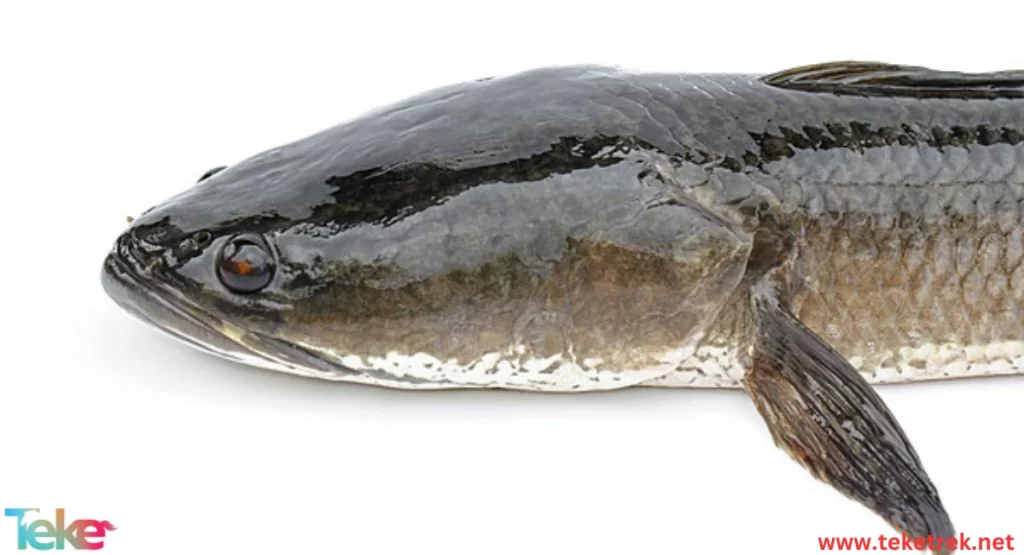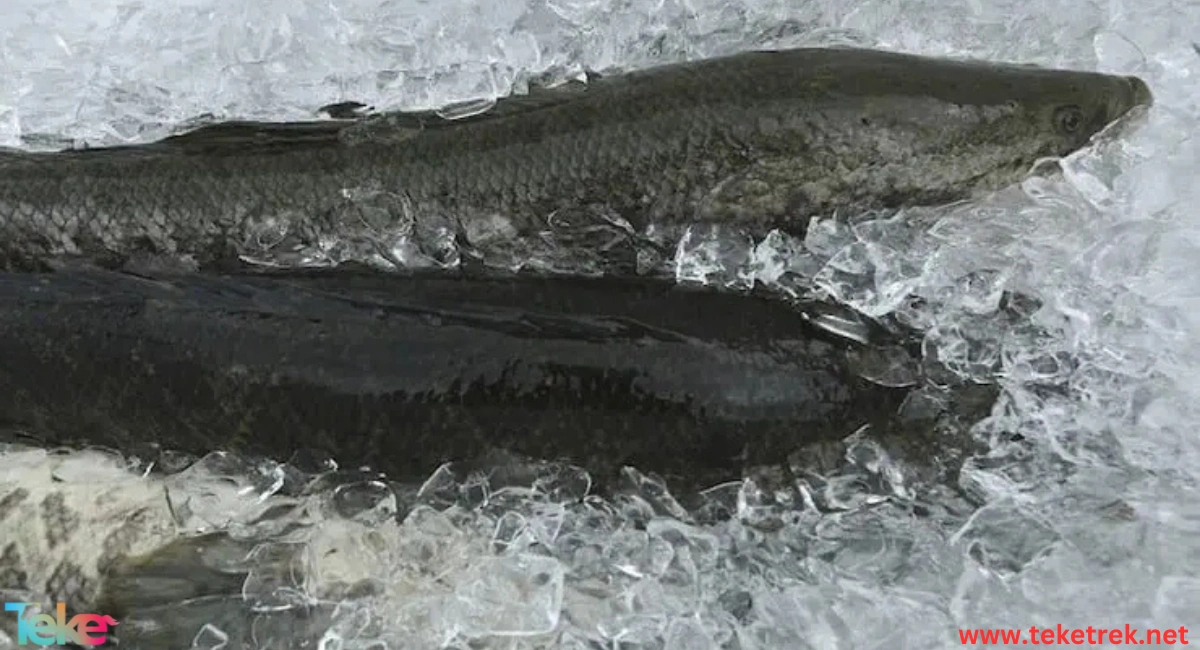The snakehead fish is known as an invasive aquatic species and gets its name from its elongated cylindrical body shape and the large scales on its head that give it a snake-like appearance.
This species is of concern because it is one of the predatory animals that disrupts the natural aquatic feeding structure in ecosystems. Let’s learn more about these fish in this article on TekeTrek.

Morphological Characteristics of the Snakehead Fish
- The snakehead fish belongs to the kingdom Animalia, phylum Chordata, subphylum Vertebrata, class Actinopterygii, and order Anabantiformes, family Channidae.
- Its scientific name is Channa argus.
- The length of the snakehead fish usually reaches 100 cm, and the weight of adult specimens can be about 15 pounds.
- The color of the northern snakehead fish is usually brown with dark, irregular spots.
- Snakehead fish have a round-shaped tail, long and thin dorsal fins, and an anal fin, as well as sharp villiform teeth arranged in bands, with large canines in the lower jaw and palate.
- There is a specialized chamber next to the gills of the snakehead that allows it to absorb oxygen by taking large breaths of air through its mouth. This enables the snakehead fish to adapt and survive for up to four days on land.
- Snakehead fish can also enter a state of hibernation, a state of inactivity, which allows them to survive at very low temperatures and under ice.
Original Habitat of the Snakehead Fish
- The native habitat of the snakehead fish is China, southern Siberia, and North Korea. It is widely spread in North America..
- Snakehead fish are amphibious animals and prefer to live in shallow ponds, swamps, slow-moving streams, which contain a lot of vegetation and muddy surfaces.
- Snakehead fish can also be found in canals, reservoirs, lakes, and rivers.
- While the optimal temperature range for northern snakehead fish is 5-16 degrees Celsius, they can withstand temperatures as low as 0 degrees Celsius and over 30 degrees Celsius.
- The ability of these fish to adapt to various depths, temperatures, and oxygen levels allows them to survive in many different types of aquatic environments.
Preferred Food of the Snakehead Fish
Northern snakeheads are aggressive carnivorous , it has teeth like dagger.
The small larvae feed on zooplankton, then on small insects and crustaceans.
Juveniles eat small fish, while adults can eat fish that are up to 33% of their body length, such as loach, dace, and carp.
Adult snakehead fish also eat dragonfly larvae, beetles, and frogs.
In the zoo, snakehead fish eat goldfish, earthworms, and crayfish.
Behavioral Characteristics of the Snakehead Fish
- These fish are usually active late at dusk and early at night.
- Snakehead fish are freshwater fish that use optional air breathing using a suprabranchial organ, in addition to the branched ventral aorta, which allows them to survive through both aquatic and aerial respiration.
- This species is social, prefers to feed after sunset usually in groups, and hunts among the aquatic vegetation near the shore.
- The snakehead fish is known to be very aggressive towards its prey, usually hunting by chasing, attacking, and biting.

Snakehead Fish Life Cycle
- These fish are capable of doubling their numbers in less than 15 months. They can mate and reproduce throughout the year and reach sexual maturity within two or three years in the wild.
- During this time, the length of the snakehead fish is about 30 to 35 cm.
- Female snakehead fish can lay up to 100,000 eggs annually.
- The eggs of this fish are externally fertilized, which occurs in shallow water, especially at dawn.
- The eggs of the snakehead fish are yellow and spherical, with a diameter of about 2 mm.
- It takes about one to two days for the young fish to emerge.
- Before hatching, both the father and the mother guard until the yolk is absorbed.
- The young of this species are capable of moving on land using waving movements.
Predators of the Snakehead Fish
Except for humans, these large fish that are at the top of the food chain have no specific predators within their environment, but it is believed that they may be preyed upon by large fish, birds, crocodiles, turtles, otters, etc.
Frequently Asked Questions About the Snakehead Fish
- Who is the snake head?
The snakehead is an invasive aquatic fish.
- How long is the average lifespan of a snakehead fish?
The average lifespan of a snakehead fish is 10 years, but it has been documented to live up to 15 years.
- What are the types of snakehead fish?
There are four types of snakehead fish:
- Channa argus (Northern snakehead)
- Channa micropeltes (Giant snakehead)
- Channa marulius (Bull’s eye snakehead)
- Channa maculates (Spotted snakehead)
- What are the benefits of eel or eel?
Prevents premature graying, fights cancerous breast tumors, and strengthens nerves, muscles and bones.
- Who are the predators of snakehead fish?
With the exception of humans, these are large fish that are at the top of the food web. They do not have any specific predators within their habitat, but it is believed that they may be preyed upon by fish, large birds, crocodiles, turtles, otters, etc.
- Is snakehead fish good to eat?
Yes, snakehead fish are good to eat.
- Are snakehead fish poisonous?
No, snakehead fish is not poisonous.


In conclusion, the snakehead fish is a predatory animal that affects the ecosystem, so we must be cautious and careful to avoid its harms.






